It’s been a little while since I posted a new blog. I’ve spent all of 1 week at home in the past 5 weeks, and I’ve got a lot of travels to fill you in on.
Let’s start by talking about the Expedition Skills course I attended last week in England’s Lake District.
If you’re planning a journey beyond the farthest fringes of the map, then you really should have this stuff in your toolkit.
I first heard about the course through a company called Wilderness Medical Training. And I expected Expedition Medicine to be the most interesting — and by far the most useful — part of the 7 day event. But the hosts at Woodsmoke absolutely blew me away with their knowledge.
Here’s the day by day breakdown of how we spent our week in the woods.
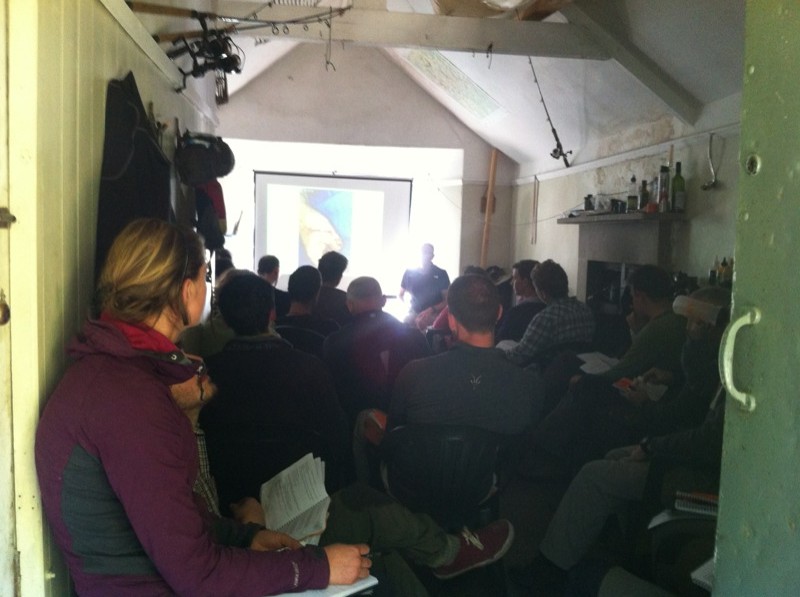
Day 1 to 3 — Expedition Skills
The first three days were devoted to bushcraft skills, but from an expedition perspective.
What the heck does that mean?
Well, we weren’t building shelters from twigs or starting fires with two sticks. You’ve generally got matches and lighters on an expedition, as well as tents or jungle hammocks. So all the skills we practiced were based on the needs of a large, properly-equipped group in remote places.
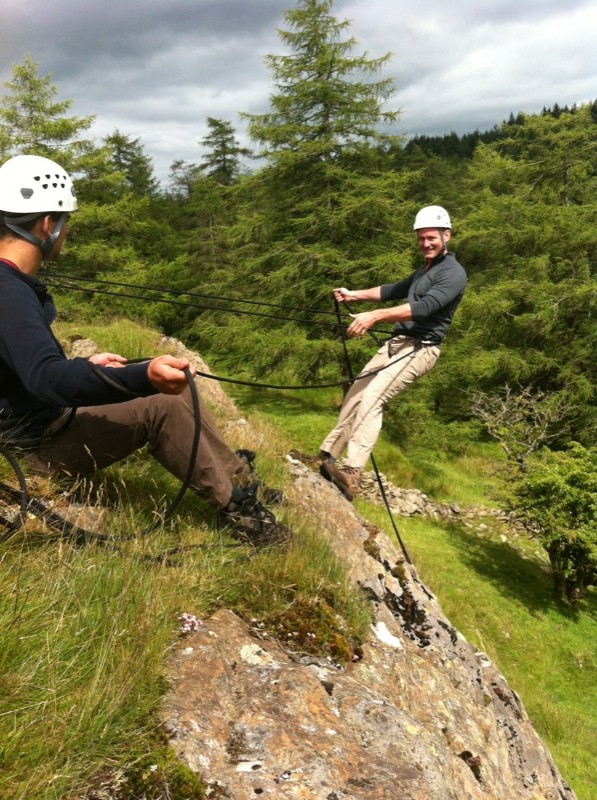
We divided into groups as soon as we arrived so we could set up the camp. One bunch put up the giant parachute we would sit under for evening campfire talks and tea. Another group (mine) threw coils of rope into the trees to lift an enormous tarp. That became our teaching area. A third group set up the kitchen, and a fourth dug the latrine.
Each task involved new skills, like tying quick release knots, creating simple rope pulley systems for mechanical advantage, maintaining proper camp hygiene for large groups, and safe use of the machete. But Ben McNutt’s Woodsmoke team didn’t just teach us the skills. We had to put them to immediate use.
Highlights of those first three days include: descending a steep rock face using a very cool rig called the South African abseil; crossing a section of the tarn on a Tyrollean line; using a machete to carve a tree into a pot-hanging system with variable heat; and cooking trout on a stick in the rain, as well as rabbit pie (…yes, I’m a failure in the kitchen, and my crust turned out more like a breadroll…).
We also covered in depth sessions on water safety and purification, and a range of fire starting methods.
And that doesn’t even scratch the surface of all the skills we learned. The first 3 days set a very high bar for the rest of the week.
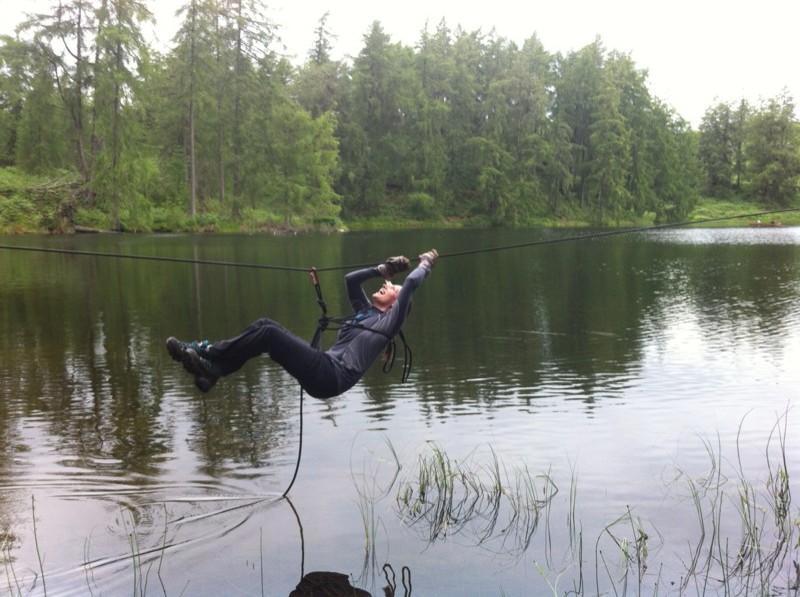
Day 4 – Bush Mechanics & 4×4 Driving
The first half of Day 4 was devoted to “bush mechanics” — how to fix a car with little more than a Leatherman multitool, gaffer tape and a rusted spoon.
We were given the shell of a Suzuki Samurai from which every unnecessary part had been removed. The only components left attached were the ones that made it go.
Our guest instructor set the scene. “You’re in the middle of Borneo,” he said. “Your last remaining vehicle has plunged into a river and was submerged up to the bonnet. You have to get it running again. It’s too far to trek out.”
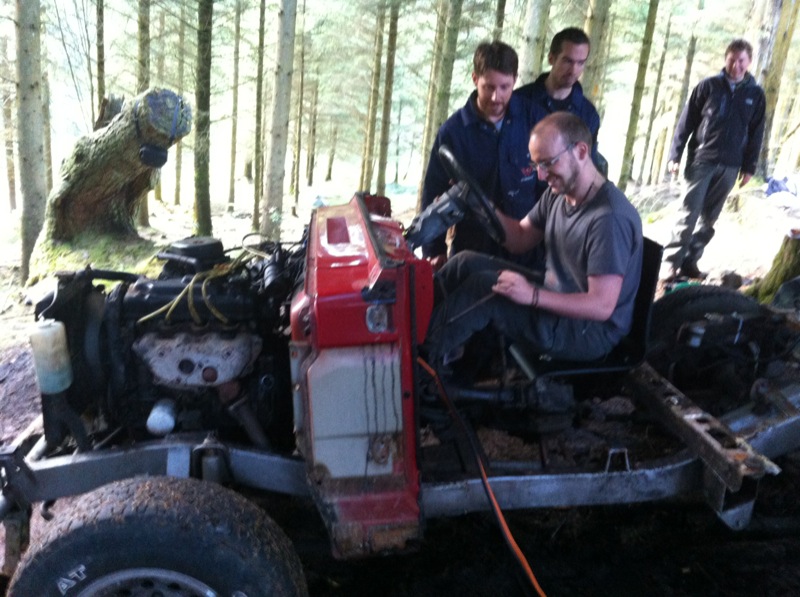
We first had to winch the vehicle up the hill, under the shelter of the tarp. He showed us how to do this using a brilliant system called a “flip flop winch”, improvised from a length of rope and two logs.
He explained the principles of how a car works, and which system is responsible for which function. He then gave us a simple task: to remove the right rear wheel. But one of the lug nuts was different than the others, and it was the one tool missing from the socket set.
And that’s when the fun began…
We had to check the cylinders for water. And when we found they were dry, our fearless leader snuck up from behind and dumped in a mug full. Every time we improvised a solution, he came along and sabotaged something else. He made the drive shaft fall off, punctured a tire and stabbed a hole in the radiator.
Each time we had to figure out what a particular system did, and how to create a solution to keep that system going. And if a particular part wasn’t all that important, we disconnected it or tore it off. The solutions we came up with would make the mechanic at your local car dealership pluck out his eyes. But on an expedition, the motto is: “Whatever gets you home.”
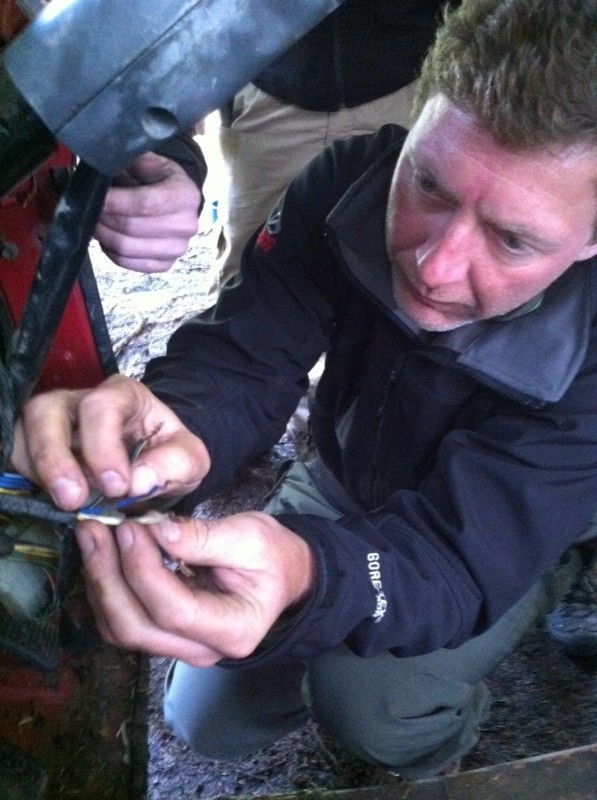
By the time lunch was ready, we had that shell of a car back in working order and successfully started the engine.
It was time to get behind the wheel. The afternoon was devoted to 4×4 driving in the hills of Cumbria.
We put a Land Rover Defender and two Mitsubishi Pajeros through their paces on steep climbs, and over rocks so large I didn’t think a car could go up them.
I’ve had a fair bit of experience with vehicle-dependent expeditions in Namibia, Mongolia and the Sahara, so most of this wasn’t new for me. But I did pick up a really cool left foot braking technique for sending steady power to all four wheels while climbing slippery rocks. And of course we got to experience the incredible scenery of the Lake District along the way.
Day 5 – GPS Navigation & Personal Security
The first half of Day 5 was devoted to the crucially important skill of navigation. Because if you don’t know where you are, you’ll never figure out where you’re going…
I’ve taken map and compass courses in the past, and used them for navigation in the field. Mostly simple stuff, paired with visual reading of topographical maps. At most we used a GPS to determine how much ground we covered that day, and where our current longitude intersected with our progress on a map so we could plot the rough location of our camp.
That being the case, I was especially interested in broadening my skills with this module.
After a brief introduction to the basic menus and functions of the Garmin eTrex 10, we took to the field with guest instructor Jim Butcher for some hands on GPS exercises.
By the time the morning session had finished, everyone walked away with a solid understanding of the basic workings of GPS navigation, and the ability to competently use these devices on expedition.
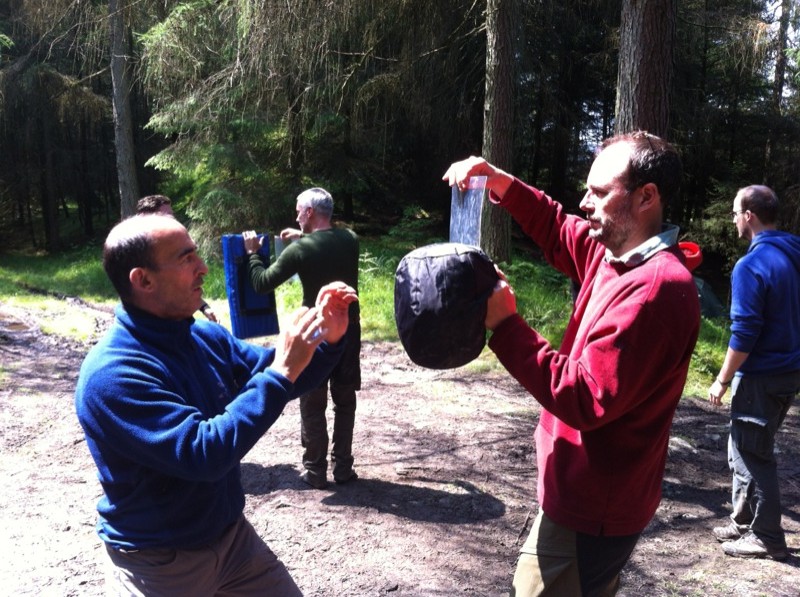
The afternoon session was devoted to personal security. Our guest instructor, Richie, is a full time police officer with a military background in special ops and anti-terrorism, including time spent hunting down indicted war criminals in Bosnia.
Because the material was taught by an anti-terrorism specialist, we received a lot of inside knowledge on how to deal with things like hostage taking, air travel incidents, counter surveillance and more.
I think some of the participants found that worldview a little too paranoid. But the entire module was taught from the perspective of situational awareness and preventative measures, and in my opinion the psychological angle was absolutely applicable to solo travel in rough places, as well as expedition security concerns. I think this is essential knowledge for anyone traveling abroad. Especially if you’re going alone.
The highlights for me were learning how to spot a concealed weapon, some new tips for hotel and airport security, improvised weapons (no one will ever forget the “broken pencil in the thigh” trick…), and pattern recognition. We also took it outside for some bag work and hand-to-hand drills.
Day 6 & 7 – Expedition Medicine
The course finally wrapped up with two solid days of Expedition Medicine training. The focus was on first aid skills in remote locations, with the goal of treating and managing typical conditions and injuries, or patching a patient up and evacuating him to a medical facility when needed.
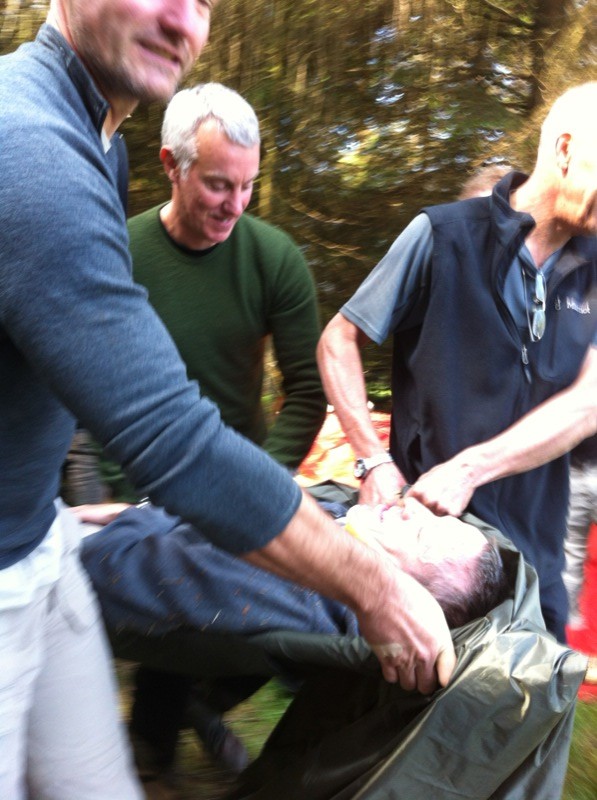
We covered a wide range of scenarios, from the all-important ABC’s (airway, breathing, circulation) to diagnosis and hands-on patient assessment, how to straighten and move a casualty, CPR, dealing with shock, bandaging, fractures & dislocations and more. Sessions also included in depth coverage of tropical diseases, cold injuries, heat illness and altitude sickness. Each powerpoint lecture was broken up by hands on practice with partners and groups.
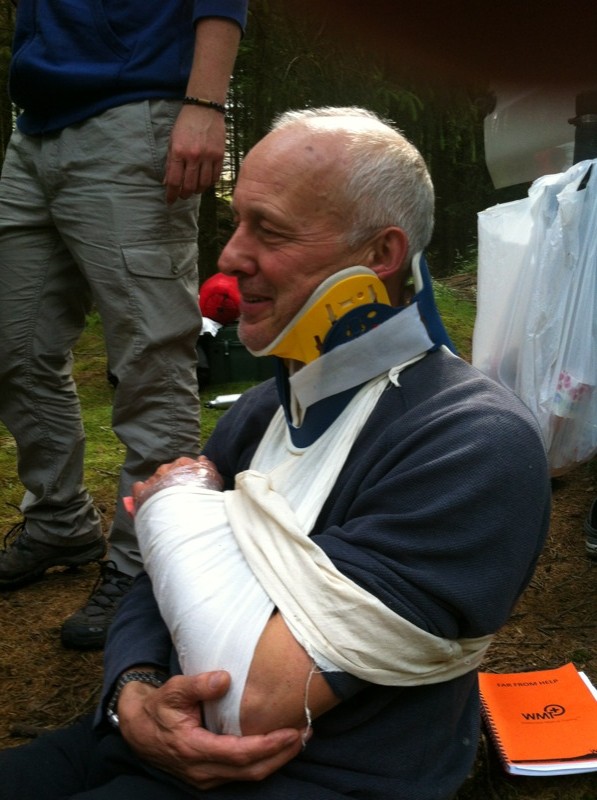
That’s a lot of material to cover in just 7 days! And don’t think we sat around the campfire telling stories in the evening either…! Ben worked us until well after 9pm every night.
Evening sessions included an extensive review of Ben’s jungle and winter expedition kits, as well as his medical kit — a fantastic resource from someone who’s done so many large scale expeditions to remote locations.
We also had sessions on how to kit out a vehicle for overland expeditions, what type of GPS to buy, and — from Richie the security expert — how to smash through a roadblock with your car, and dealing with hostile crowds while driving.
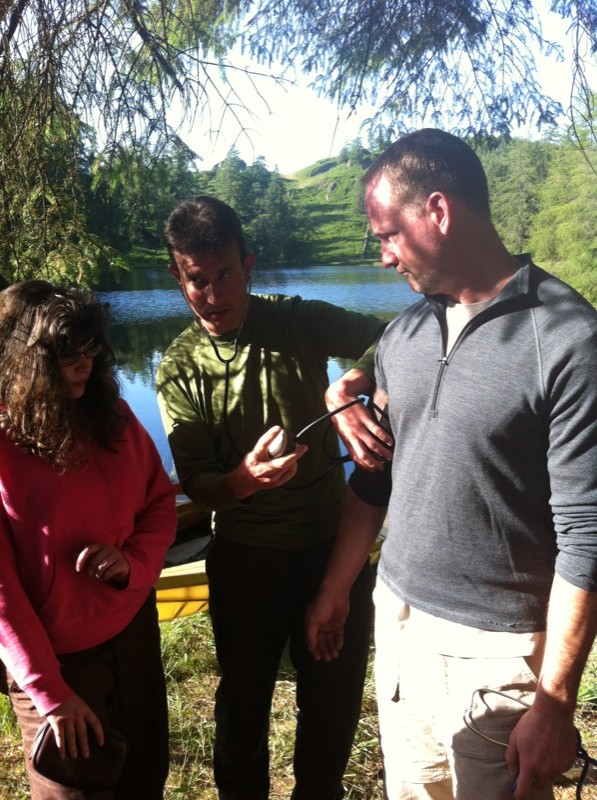
This barely scratches the surface of what we covered in an amazing week. I’ve got a notebook full of new skills to practice, and a pile of references to look up and dig into.
There was giggling too, of course. I managed to connect with several other bad influences, and we got an amazing abdominal workout watching Barney from Woodsmoke demonstrate axe techniques (“…grip your shaft firmly and use an oval motion…”). But those stories belong to the campfire.
Thanks again to Ben, our guest instructors and the entire Woodsmoke team. If you’re heading off on expedition — or if you’re even considering a long overland trip — I highly recommend attending this course. It’ll save you time and money on crap you don’t need, and you’ll be well prepared for whatever adventures the Road throws at you.
I look forward to heading north again to attend a Woodlander course in the near future.

